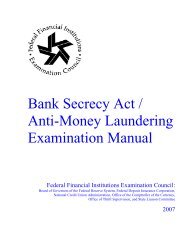Annual Report 2012 - ffiec
Annual Report 2012 - ffiec
Annual Report 2012 - ffiec
You also want an ePaper? Increase the reach of your titles
YUMPU automatically turns print PDFs into web optimized ePapers that Google loves.
tions to (1) better reflect risk in a<br />
timely manner, (2) differentiate<br />
large institutions during periods of<br />
good economic conditions, and (3)<br />
take into account the losses that the<br />
FDIC may incur if such an institution<br />
fails.<br />
Supervision: The FDIC has primary<br />
federal regulatory and supervisory<br />
authority over insured state-chartered<br />
banks that are not members<br />
of the Federal Reserve System and<br />
for state-chartered savings associations.<br />
As deposit insurer, the<br />
FDIC also has backup examination<br />
and enforcement authority over all<br />
insured institutions. Accordingly,<br />
the FDIC can examine for insurance<br />
purposes any insured financial<br />
institution, either directly or<br />
in cooperation with state or other<br />
federal supervisory authorities. The<br />
FDIC can also recommend that the<br />
appropriate federal banking agency<br />
take action against an insured institution<br />
and may do so itself if it<br />
deems necessary. The Dodd-Frank<br />
Act also authorizes the FDIC to<br />
manage the failure of systemically<br />
significant firms.<br />
The FDIC’s supervisory activities<br />
for risk management and consumer<br />
protection are primarily organized<br />
into two divisions, the Division<br />
of Risk Management Supervision<br />
(RMS) and the Division of Depositor<br />
and Consumer Protection<br />
(DCP). RMS oversees the safety<br />
and soundness of FDIC-supervised<br />
institutions. DCP oversees the<br />
FDIC’s consumer protection functions,<br />
including its examination and<br />
enforcement programs for FDICsupervised<br />
institutions with assets<br />
of $10 billion or less. Under the<br />
Dodd-Frank Act, the FDIC retains<br />
examination and enforcement<br />
authority for several laws and regulations,<br />
including the Community<br />
Reinvestment Act, without regard<br />
to the size of an institution.<br />
These two divisions are further<br />
organized into six regional offices<br />
located in Atlanta, Chicago, Dallas,<br />
Kansas City, New York, and<br />
San Francisco; and two area offices<br />
located in Boston (reports to New<br />
York) and Memphis (reports to<br />
Dallas). In addition to the regional<br />
and area offices, the FDIC maintains<br />
86 field offices for risk management<br />
and 76 field offices for<br />
compliance, with dedicated examiners<br />
assigned to many of the largest<br />
financial institutions.<br />
Receivership Management:<br />
Bank resolutions are handled<br />
by the Division of Resolutions<br />
and Receiverships. In protecting<br />
insured deposits, the FDIC<br />
is charged with resolving failed<br />
depository institutions at the least<br />
possible cost to the DIF. In carrying<br />
out this responsibility, the<br />
FDIC engages in several activities,<br />
including paying off depositors,<br />
arranging the purchase of<br />
assets and assumption of liabilities<br />
of failed institutions, effecting<br />
insured deposit transfers between<br />
institutions, creating and operating<br />
temporary bridge banks until<br />
a resolution can be accomplished,<br />
and using its conservatorship<br />
powers.<br />
Also, the Dodd-Frank Act vests<br />
the FDIC with authority to resolve<br />
a failing systemically important<br />
financial company, including a<br />
bank holding company, if use of<br />
that authority would avoid or<br />
mitigate potential adverse consequences<br />
for the financial system,<br />
and complies with other statutory<br />
standards. Consistent with these<br />
responsibilities, as well as its role<br />
on the FSOC helping to promote<br />
financial stability, the FDIC has<br />
backup examination authority to<br />
include certain bank holding companies<br />
and systemically- important<br />
financial companies designated<br />
by the FSOC for supervision<br />
by the FRB.<br />
The Division of Resolutions and<br />
Receiverships maintains personnel<br />
in its field office in Dallas and<br />
its temporary satellite office in<br />
Jacksonville, Florida; it also maintains<br />
staff in each of the FDIC<br />
regional and area offices.<br />
Office of Complex Financial<br />
Institutions<br />
The Office of Complex Financial<br />
Institutions (OCFI) is an organization<br />
within the FDIC created to<br />
provide a comprehensive focus<br />
to the supervisory, insurance,<br />
and resolution risks posed by the<br />
largest and most complex financial<br />
institutions. The organization<br />
ensures the effective evaluation,<br />
analysis, management, and mitigation<br />
of risk related to large and<br />
complex financial institutions.<br />
OCFI develops strategies, metrics,<br />
and supervisory plans to ensure<br />
readiness to conduct the resolution<br />
of large and complex financial<br />
institutions, thereby reducing<br />
loss exposure to the DIF and<br />
mitigating systemic risks. OCFI<br />
defines and executes the FDIC's<br />
evolving role in the oversight<br />
of large financial firms, including<br />
the expanded responsibilities<br />
assigned the FDIC by the Dodd-<br />
Frank Act. This operational group<br />
complements and enhances the<br />
FDIC’s operational activities, as<br />
they relate to systemically significant<br />
institutions.<br />
27

















